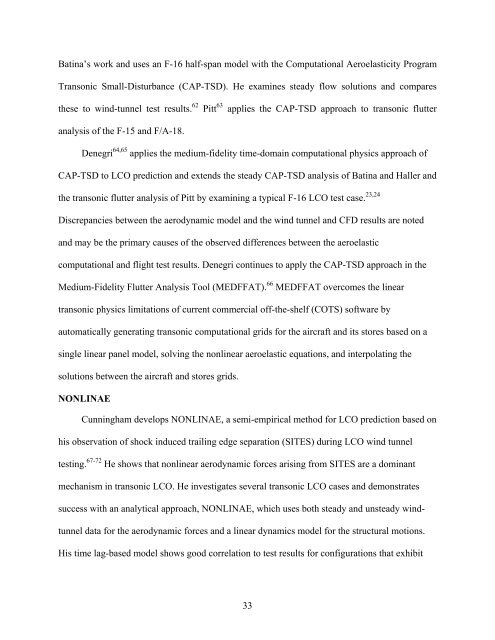university of florida thesis or dissertation formatting template
university of florida thesis or dissertation formatting template
university of florida thesis or dissertation formatting template
You also want an ePaper? Increase the reach of your titles
YUMPU automatically turns print PDFs into web optimized ePapers that Google loves.
Batina’s w<strong>or</strong>k and uses an F-16 half-span model with the Computational Aeroelasticity Program<br />
Transonic Small-Disturbance (CAP-TSD). He examines steady flow solutions and compares<br />
these to wind-tunnel test results. 62 Pitt 63 applies the CAP-TSD approach to transonic flutter<br />
analysis <strong>of</strong> the F-15 and F/A-18.<br />
Denegri 64,65 applies the medium-fidelity time-domain computational physics approach <strong>of</strong><br />
CAP-TSD to LCO prediction and extends the steady CAP-TSD analysis <strong>of</strong> Batina and Haller and<br />
the transonic flutter analysis <strong>of</strong> Pitt by examining a typical F-16 LCO test case. 23,24<br />
Discrepancies between the aerodynamic model and the wind tunnel and CFD results are noted<br />
and may be the primary causes <strong>of</strong> the observed differences between the aeroelastic<br />
computational and flight test results. Denegri continues to apply the CAP-TSD approach in the<br />
Medium-Fidelity Flutter Analysis Tool (MEDFFAT). 66 MEDFFAT overcomes the linear<br />
transonic physics limitations <strong>of</strong> current commercial <strong>of</strong>f-the-shelf (COTS) s<strong>of</strong>tware by<br />
automatically generating transonic computational grids f<strong>or</strong> the aircraft and its st<strong>or</strong>es based on a<br />
single linear panel model, solving the nonlinear aeroelastic equations, and interpolating the<br />
solutions between the aircraft and st<strong>or</strong>es grids.<br />
NONLINAE<br />
Cunningham develops NONLINAE, a semi-empirical method f<strong>or</strong> LCO prediction based on<br />
his observation <strong>of</strong> shock induced trailing edge separation (SITES) during LCO wind tunnel<br />
testing. 67-72 He shows that nonlinear aerodynamic f<strong>or</strong>ces arising from SITES are a dominant<br />
mechanism in transonic LCO. He investigates several transonic LCO cases and demonstrates<br />
success with an analytical approach, NONLINAE, which uses both steady and unsteady wind-<br />
tunnel data f<strong>or</strong> the aerodynamic f<strong>or</strong>ces and a linear dynamics model f<strong>or</strong> the structural motions.<br />
His time lag-based model shows good c<strong>or</strong>relation to test results f<strong>or</strong> configurations that exhibit<br />
33
















